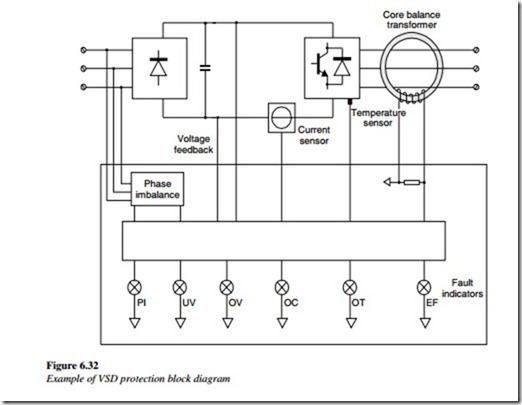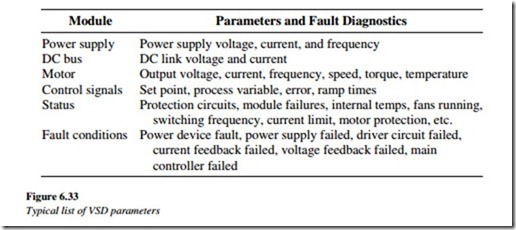Overall protection and diagnostics
Figure 6.32 is a summary of the protection features commonly used in modern digital PWM AC converters. As outlined above, many of these protection functions are implemented in software, using suitable algorithms. The main exceptions are the over- current protection and the earth fault protection. These are implemented in hardware, to ensure that they are sufficiently fast to adequately protect the power semiconductor devices.
The normal protection features that are available with an inverter-based VSD are phase imbalance, under voltage, over voltage, over current, over temperature, and earth fault. Protection features require, sensor-like CTs, voltage transformers, and temperature sensors. These are installed and adequate indications are provided for the same.
Operator information and fault diagnostics
Modern digital VSDs all have some form of an operator interface module. This module provides access to internal data, about the control and status parameters during normal operation and diagnostic information during fault conditions. This module is called the human interface module (HIM) or a name on similar lines. The HIM usually provides an LED or LCD display and buttons to interrogate the control circuit. This operator interface can also be used to install and change the VSD settings parameters.
When an internal or an external fault occurs, the control circuit registers the fault type. This helps to identify the cause of the fault and the subsequent rectification required. Modern microprocessor-controlled converters employ a diagnostic system. The system monitors both, the internal and the external operating conditions and responds to any faults. This is done in the manner programed by the user. The control system retains the fault information in a non-volatile memory for later analysis. This feature is known as fault diagnostics.
There are three main levels of operator information and fault diagnostics in reputed models, as given below:
• The first level provides information about the on-going situation inside a VSD. It refers mainly to the setting parameters and the real-time operating parameters. It meters information, such as output voltage, output current, output frequency, etc.
• The second level provides diagnostic information, about the status of the protection circuits, and indicates the external faults, as described above.
• The third level provides diagnostic information about the status of internal faults, such as the identification of failed modules. Dedicated internal diagnostics are usually only found in high-performance VSDs.
Figure 6.33 is a brief list of typical internal parameters and fault conditions.
Power supply Power supply voltage, current, and frequency DC bus DC link voltage and current Motor Output voltage, current, frequency, speed, torque, temperature Control signals Set point, process variable, error, ramp times Status Protection circuits, module failures, internal temps, fans running, switching frequency, current limit, motor protection, etc.
Fault conditions Power device fault, power supply failed, driver circuit failed, current feedback failed, voltage feedback failed, main
At the first level, most modern digital VSDs provide information about the status of the following:
• All setting parameters which define operating conditions
• The digital inputs (DI) and digital outputs (DO), such as start, stop, enabled, jog, forward/reverse, etc.
• The status of the analog inputs (AI), such as speed reference, torque reference, etc.
• The real-time operating parameters, which include a vast array of information, such as output frequency, output voltage, output current, etc.
At the second level, when a fault occurs and the VSD stops, diagnostic information is provided to assist in the rectification of the fault, thereby reducing downtime. There is always some overlap between these levels of diagnostics. For example, a persistent over- current trip with no motor connection can indicate a failed power electronic switching device inside the converter.
Figure 6.34 shows the most common external fault indications provided by the VSD diagnostics system, and the possible internal or external problems which may have caused them.
The internal diagnostics system can provide an operator with information about faults that have occurred inside the drive. This can be further broken down into fault conditions, such as a failed output device, commutation failures, etc. Fault conditions are indications that a particular module or device has failed or is not operating normally.
To provide fault condition monitoring, the drive must be specifically designed to include internal fault diagnostic circuits. For example, power semiconductor drivers may
include circuits that measure the saturation voltage, which is the voltage across the device when it is on, for each power semiconductor. This can identify a short-circuit in the power switch and the VSD can be shut down before the external over-current trips or the fuses can operate.
Considerable cost and effort is required to implement the internal fault condition monitoring. Only a few high-performance VSDs provide extensive internal diagnostics.
This feature can be very useful for troubleshooting, but this is usually only warranted when downtime represents a major cost to the user.


